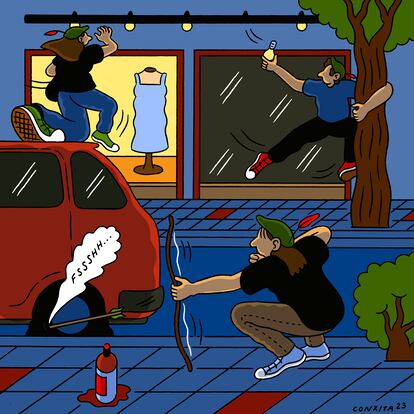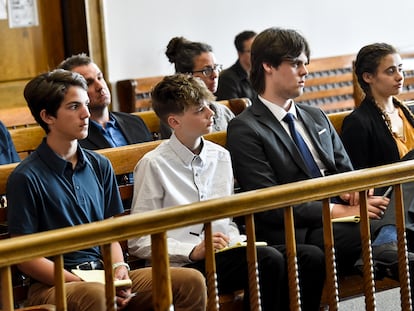Activism with ingenuity: when activism and creativity come together to change the world
Civil disobedience takes on new forms of struggle in Paris, London and Bogotá through organized groups that paint cracked sidewalks and turn off brightly lit shop signs, but also to slash tires

On any given day in London, drivers of high-end SUVs may be in for a surprise: flat tires and a note on the windshield saying, “It’s not you, it’s your car,” followed by an explanation of why such vehicles are particularly harmful to the environment. These manifestos are signed by The Tyre Extinguishers, a group that was born in 2021 in the United Kingdom. It was founded by young people who decided to mobilize and stigmatize all those cars, which they consider “a climate disaster, polluting, dangerous and unnecessary,” according to a document published on their website. Its members are organized and roam the streets at night, slashing the tires of every SUV they can find. The new activists’ arguments have permeated society. In two years they already have a presence in 10 countries, from New Zealand to Switzerland. In 2022, a spokesperson for the organization says they have slashed the tires of 9,000 vehicles worldwide. They also point out that the numbers are even higher because their members do not always report all their militant activity.
A few hundred miles from London, in Paris, there is another group of vigilantes who also operate in the streets at night with very particular methods. They always wear sports clothing because their activism involves running, climbing, and jumping. They are called On the Spot Parkour and their enemies are the shop signs that are lit up past 1.00am in the French capital. These young activists do not attack or damage the city’s businesses in any way. Their goal is to turn off the lights while making the most of the sport they enjoy. They do it just through “common sense,” as a representative of the group explains. In the beginning, he says, they didn’t even consider themselves an environmental group, but were simply friends who did parkour at night. That is, until the idea came up on time to use their skills to jump and reach the outside switches of the illuminated signs and turn them off. “From then on, we gave it an environmental focus,” he says.
At another latitude, there is a third example of new sui generis activism. It is a group called Empecemos (Let’s start) that performs in broad daylight in the streets of Bogotá. Their mission is to mark the Colombian capital’s abundant broken flagstones with graffiti, to avoid accidents. The initiative was born in February of this year, after Nicolás de Francisco, a 35-year-old engineer, decided to take an aerosol can and go paint the tile that an elderly man had tripped over, injuring his arm. He started looking for other volunteers and since then the movement has been growing. According to De Francisco, around 100 volunteers have already marked more than 11,000 tiles. “You see a sidewalk in bad shape, you contact us on Instagram or TikTok, and we send a volunteer to the area,” says the engineer. The response from the Bogotá community has been, as he explains, “unbeatable”: “Poor infrastructure is an everyday problem in Bogota and people are very grateful for our work.” The Empecemos leader claims that the authorities have already fixed some of the thousands of tiles they have marked.
These three groups of young people, with all their differences, fit into the new forms of activism described in an article signed by five academics and published in the British newspaper The Guardian. The text highlights how, since the beginning of the Covid-19 pandemic, activists around the world had been devising new and creative strategies in their struggles for social change. At first they were forced to be crafty because of the lockdowns, but three years later these three groups show how creativity has permeated citizen activism.
Empecemos and On the Spot Parkour post their activity on social networks with absolute peace of mind and have never had any problems with the authorities. In the case of Parisians, in their city, storefront illuminations must be shut off between 1.00am and 6.00am, so they act to enforce the law. They say in their responses that they have even received support on some occasions from the police. In this they diverge from The Tyre Extinguishers’ anti-SUV operation, whose members work underground because they cause property damage. The English group has stated that so far no member of the group has been arrested. “Unless the police decide to monitor every SUV in every urban area in the world, they won’t be able to stop us,” they point out. Of course, in the email they advertise on their website, they receive plenty of insulting messages from angry owners of damaged vehicles. None of this discourages them from continuing their tire-slashing excursions: “The only thing we’re afraid of is the climate catastrophe we’re heading for if things don’t change.”
De Francisco, for his part, knows that the poor infrastructure in Bogotá goes beyond the damaged tiles, but he will be satisfied if his graffiti can prevent more accidents.
The aim of these groups, examples of a new type of activism, is to draw attention to problems that are not always on the public agenda. Until this changes, they will continue to paint tiles, turn off lights and slash tires.
Sign up for our weekly newsletter to get more English-language news coverage from EL PAÍS USA Edition
Tu suscripción se está usando en otro dispositivo
¿Quieres añadir otro usuario a tu suscripción?
Si continúas leyendo en este dispositivo, no se podrá leer en el otro.
FlechaTu suscripción se está usando en otro dispositivo y solo puedes acceder a EL PAÍS desde un dispositivo a la vez.
Si quieres compartir tu cuenta, cambia tu suscripción a la modalidad Premium, así podrás añadir otro usuario. Cada uno accederá con su propia cuenta de email, lo que os permitirá personalizar vuestra experiencia en EL PAÍS.
¿Tienes una suscripción de empresa? Accede aquí para contratar más cuentas.
En el caso de no saber quién está usando tu cuenta, te recomendamos cambiar tu contraseña aquí.
Si decides continuar compartiendo tu cuenta, este mensaje se mostrará en tu dispositivo y en el de la otra persona que está usando tu cuenta de forma indefinida, afectando a tu experiencia de lectura. Puedes consultar aquí los términos y condiciones de la suscripción digital.
More information
Archived In
Últimas noticias
All the effects of gentrification in one corner of Mexico’s Colonia Roma
Palestinian reporter Youmna El Sayed: ‘My family told me I had to choose between being a journalist or a mother’
Russell Tovey: ‘I was advised many times not to come out, I don’t think there was many people who’d done that — and I feel really proud that I’m one of those that did’
Patagonia’s puma population soars thanks to unexpected prey: penguins
Most viewed
- The low-cost creative revolution: How technology is making art accessible to everyone
- Christian Louboutin: ‘Young people don’t want to be like their parents. And if their parents wear sneakers, they’re going to look for something else’
- US sanctions against jailed cartel leader ‘El Marro’ highlight Mexico’s lack of control over its prisons
- Families demand repatriation of bodies of Colombians who died in Ukraine: ‘This war is a slaughterhouse for foreigners’
- Liset Menéndez de la Prida, neuroscientist: ‘It’s not normal to constantly seek pleasure; it’s important to be bored, to be calm’











































